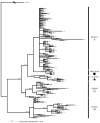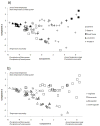Phylogeographic analysis and environmental niche modeling of the plain-bellied watersnake (Nerodia erythrogaster) reveals low levels of genetic and ecological differentiation
- PMID: 20302955
- PMCID: PMC3322375
- DOI: 10.1016/j.ympev.2010.03.012
Phylogeographic analysis and environmental niche modeling of the plain-bellied watersnake (Nerodia erythrogaster) reveals low levels of genetic and ecological differentiation
Abstract
Species that exhibit geographically defined phenotypic variation traditionally have been divided into subspecies. Subspecies based on phenotypic features may not comprise monophyletic groups due to selection, gene flow, and/or convergent evolution. In many taxonomic groups the number of species once designated as widespread is dwindling rapidly, and many workers reject the concept of subspecies altogether. We tested whether currently recognized subspecies in the plain-bellied watersnake Nerodia erythrogaster are concordant with relationships based on mitochondrial markers, and whether it represents a single widespread species. The range of this taxon spans multiple potential biogeographic barriers (especially the Mississippi and Apalachicola Rivers) that correspond with lineage breaks in many species, including other snakes. We sequenced three mitochondrial genes (NADH-II, Cyt-b, Cox-I) from 156 geo-referenced specimens and developed ecological niche models using Maxent and spatially explicit climate data to examine historical and ecological factors affecting variation in N. erythrogaster across its range. Overall, we found little support for the recognized subspecies as either independent evolutionary lineages or geographically circumscribed units and conclude that although some genetic and niche differentiation has occurred, most populations assigned to N. erythrogaster appear to represent a single, widespread species. However, additional sampling and application of nuclear markers are necessary to clarify the status of the easternmost populations.
2010 Elsevier Inc. All rights reserved.
Figures






Similar articles
-
Phylogenetics of Kingsnakes, Lampropeltis getula Complex (Serpentes: Colubridae), in Eastern North America.J Hered. 2017 May 1;108(3):226-238. doi: 10.1093/jhered/esw086. J Hered. 2017. PMID: 28119446
-
Complex evolution in the Neotropics: the origin and diversification of the widespread genus Leptodeira (Serpentes: Colubridae).Mol Phylogenet Evol. 2009 Dec;53(3):653-67. doi: 10.1016/j.ympev.2009.07.022. Epub 2009 Jul 28. Mol Phylogenet Evol. 2009. PMID: 19643196
-
Lineage diversification in a widespread species: roles for niche divergence and conservatism in the common kingsnake, Lampropeltis getula.Mol Ecol. 2009 Aug;18(16):3443-57. doi: 10.1111/j.1365-294X.2009.04292.x. Epub 2009 Jul 31. Mol Ecol. 2009. PMID: 19659478
-
Fuzzy boundaries: color and gene flow patterns among parapatric lineages of the western shovel-nosed snake and taxonomic implication.PLoS One. 2014 May 21;9(5):e97494. doi: 10.1371/journal.pone.0097494. eCollection 2014. PLoS One. 2014. PMID: 24848638 Free PMC article.
-
Lizards as model organisms for linking phylogeographic and speciation studies.Mol Ecol. 2010 Aug;19(16):3250-70. doi: 10.1111/j.1365-294X.2010.04722.x. Epub 2010 Jul 8. Mol Ecol. 2010. PMID: 20618905 Review.
Cited by
-
Bayesian tests of topology hypotheses with an example from diving beetles.Syst Biol. 2013 Sep;62(5):660-73. doi: 10.1093/sysbio/syt029. Epub 2013 Apr 28. Syst Biol. 2013. PMID: 23628960 Free PMC article. Review.
-
Regional patterns of genetic structure and environmental differentiation in willow populations (Salix humboldtiana Willd.) from Central Mexico.Ecol Evol. 2019 Aug 2;9(17):9564-9579. doi: 10.1002/ece3.5475. eCollection 2019 Sep. Ecol Evol. 2019. PMID: 31534675 Free PMC article.
-
Reevaluation of a classic phylogeographic barrier: new techniques reveal the influence of microgeographic climate variation on population divergence.Ecol Evol. 2013 Jun;3(6):1603-13. doi: 10.1002/ece3.576. Epub 2013 Apr 25. Ecol Evol. 2013. PMID: 23789071 Free PMC article.
-
Existence of Bov-B LINE Retrotransposons in Snake Lineages Reveals Recent Multiple Horizontal Gene Transfers with Copy Number Variation.Genes (Basel). 2020 Oct 22;11(11):1241. doi: 10.3390/genes11111241. Genes (Basel). 2020. PMID: 33105659 Free PMC article.
References
-
- Alfaro ME, Arnold SJ. Molecular systematics and evolution of Regina and the thamnophiine snakes. Mol Phylogen Evol. 2001;21:408–423. - PubMed
-
- Arbogast BS, Kenagy GJ. Comparative phylogeography as an integrative approach to historical biogeography. J Biogeogr. 2001;28:819–825.
-
- Avise JC, Ball RM. Principles of genealogical concordance in species concepts and biological taxonomy. Oxford University Press; Oxford: 1990.
-
- Bond JE, Stockman AK. An Integrative Method for Delimiting Cohesion Species: Finding the Population-Species Interface in a Group of Californian Trapdoor Spiders with Extreme Genetic Divergence and Geographic Structuring. Syst Biol. 2008;57:628–646. - PubMed
-
- Bonett RM, Chippindale PT. Speciation, phylogeography, and evolution of life history and morphology in plethodontid salamanders of the Eurycea multiplicata complex. Mol Ecol. 2004;13:1189–1203. - PubMed
Publication types
MeSH terms
Substances
Grants and funding
LinkOut - more resources
Full Text Sources

